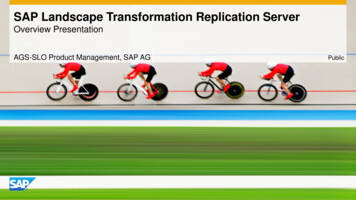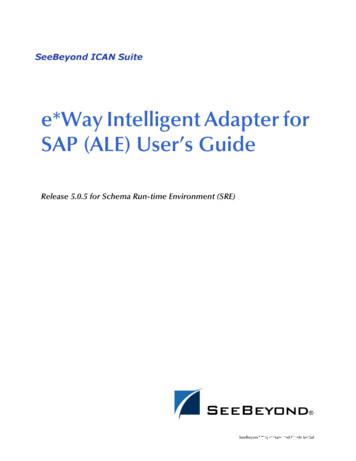SAP Security Concepts, Segregation Of Duties, Sensitive .
SAP Security Concepts,Segregation of Duties,Sensitive Access &Mitigating ControlsJonathan LevittMarch 2015
Agenda1. Introduction2. SAP Security Design Overview3. The SAP Authorization Concept4. Approaches to SAP Security5. Segregation of Duties & Sensitive Access6. Mitigating Controls7. QuestionsPwCMarch 20152
ObjectivesAt the end of the session, the participant will: Gain an understanding of the SAP security environment and why security is importantto the audit; Define and understand what a segregation of duties conflict in SAP is, and how tomonitor/address it; and Define and understand mitigating controls.PwCMarch 20153
SAP Security Design OverviewPwCMarch 20154
SAP Security Design OverviewIntroductionWhat is SAP Security Design?At its most fundamental level, SAP Security Design refers to the architectural structure ofSAP security roles. However, effective security design is achieved via the convergence ofrole architecture:1.SAP Security Organizational Structure & Governance- Ownership, Policies, and Accountability2.SAP Security Processes- User Provisioning, Role Change Management, Emergency Access3.Ongoing Management & Monitoring of the Security Environment- KPIs, Recertification, “Get Clean & Stay Clean”PwCMarch 20155
SAP Security Design OverviewIntroductionSecurity &ProvisioningProcessesOrgStructure &GovernanceSAP SecurityArchitectureMonitoringMEffective SAPSecurity DesignManagementPwCMarch 20156
SAP Security Design OverviewSAP Security Design Challenges User provisioning process withinsufficient automation &information Role Change Mgmt lacks risk andquality controls Inefficient emergency support processSecurity &ProvisioningProcessesOrgStructure &GovernanceSAP SecurityArchitecture Management KPIs for Security Designare not established Lack of automation for ongoingmonitoring & recertificationprocedures Insufficient SoD and/or Mitigatingcontrol frameworksM Misalignment of IT vs BusinessObjectives Lack of Strategic Security DesignDecisions No Role or Security DesignOwnership Overly Complex Security Design Lacks flexibility to respond toongoing changes Lacks scalability to grow withorganization Inefficient Role Build Approach No Documentation of SecurityMonitoringControl Points Inherent Segregation of DutiesRiskEffective SAPSecurity DesignManagementPwCMarch 20157
SAP Security Design OverviewAudit Issues & Complexity Poor security can lead to audit issues‒ When access controls are not in place, it impact the amount of reliance audit canplace on reports coming from SAP‒ Segregation of Duties is a key underlying principle of internal controls, and is theconcept of having more than one person required to complete a task. Security canhave a detrimental impact on this control (to be discussed in greater detail later inpresentation). It is sometimes difficult for auditors to dig deep into SAP because security is complex:‒ In SAP ERP 6.0o 108,000 transaction codeso 2,600 authorization objects‒ Several transaction codes can perform similar tasksPwCMarch 20158
The SAP Authorization ConceptPwCMarch 20159
The SAP Authorization ConceptIntroductionSecurity &ProvisioningProcessesOrgStructure &GovernanceSAP SecurityArchitectureMonitoringMEffective SAPSecurity DesignManagementPwCMarch 201510
The SAP Authorization ConceptIntroduction (continued)SAP SecurityArchitectureSecurity within the SAP application is achieved through theauthorization concept.The authorization concept is to help establish maximum security, sufficient privileges forend users to fulfil their job duties, and easy user maintenance.PwCMarch 201511
The SAP Authorization ConceptThree levels of security in SAPUser masterrecordUser requires validuser-ID and password1T-code checkUser requires anauthorization fortransactions2Authority checkUser requires anauthorization forunderlyingauthorization objectsand field valuesPwC3March 201512
The SAP Authorization ConceptThe ComponentsSAP User Master RecordMaster data for SAP usersProfilesContainer of authorizationsRolesContains transaction codes, authorizations(mapped to one profile) and user assignmentsAuthority CheckPerformed by SAP to help establish that a userhas the correct authorization to execute aparticular task.Authorization Object:Template for security that contains fields withblank valuesAuthorization (Field Values):Authorization object with completed fieldsPwCMarch 201513
The SAP Authorization ConceptBringing it togetherLet’s make an analogy the Lock and the KeyTo open the lock, the proper key must be cut specifically fora certain lockPwCMarch 201514
The SAP Authorization ConceptUser TypesSAP AuthorizationStructureUser UserRoleProfileAuthorizationPwCMarch 201515
The SAP Authorization ConceptAuthorization StructureSAP AuthorizationStructureUserRoleAuthorization is not the same astransaction. Why?ProfileAuthorizationIn SAP, you can perform the samefunction with different transactions.PwCMarch 201516
The SAP Authorization ConceptAuthorization Structure (continued)SAP AuthorizationStructureUserSAP Program AccessElements RoleSAP is delivered withabout 1500 authorizationobjectsAn object is a structureprovided by SAP to grantaccess to a data elementor a task in aspecific AuthorizationField ValuesAuthorizationObject FieldsMarch 201517
The SAP Authorization ConceptAuthorization Structure (continued)SAP AuthorizationStructureSAP AuthorizationStructureSAP Program AccessElementsUserRoleMenu ItemsUSOBT CUSOBX horizationObjectAuthorizationField ValuesAuthorizationObject FieldsMarch 201518
The SAP Authorization ConceptWhy are authorization objects required?In SAP, you can perform the same function with different transactions:Transaction CodeMK01FK01XK01Conventional approachprotection via menu/functionCreate VendorPwCSAP approach protectiononce via authorizationMarch 201519
The SAP Authorization ConceptThe Authority CheckTransaction Code check:ObjectS TCODEStart T CodeField 1TCDStart T CodeFB03Authorization check:PwCObjectF BKPF BUKDisplay postingField 1ACTVTDisplayField 2BUKRSCompany Code031000March 201520
Approaches to SAP SecurityPwCMarch 201521
SAP Security ApproachesTask Based vs. Job Based Security DesignJob Based: Security is built based on positions/jobs withinthe organization, such as AR credit associate. PwCTask Based: Provisioning access is based on jobresponsibilities.Security is built based on small, definable tasks,executed by the user, such as process cashreceipts. Smaller number of roles per user – increased riskfor granting functionality more than once.Larger number of roles per user – decreased riskof duplicate access. Transaction codes and authorizations typicallyduplicated in many roles.Transaction codes in one roles with minimalexceptions User assignment flexibility – simple to grantadditional access to only the tasks necessary. Supports future growth and sustainability – rolemodification decreased as a result offunctionality improvements and rollouts. Appropriate for dynamic organizations.Users may be granted more access than necessaryas a result of “additional job” or backupresponsibilities.Appropriate for static organizations.March 201522
SAP Security ApproachesJob Based Security Design Security roles are built based on positions/jobs for a group of users (e.g. AccountsPayable Clerk). A single role contains the access to perform a job. Transaction codes and authorizations typically duplicated in many roles.APSupervisorAPClerkAP ManagerPwCMarch 201523
SAP Security ApproachesTask Based Security DesignA task-based design begins by bucketing transactions into one of 4 access tiers: General, Display,Functional and Control Point. Task-based roles contain access to only one of these tiers.USER PROFILETIER 1: GENERAL ACCESSGeneral access is provisioned via one single rolemade up of tasks common to users such asprinting, inbox, SU53, etc.TIER 2: DISPLAY ACCESSDisplay access is provisioned via a set of rolesdefined by functional area that allow displayand reporting access intended to complimentthe functional roles of the users.WhatUser GeneralAR Common DisplayDisplayAPContract MaintenanceWherePwCFI Common DisplayProcess BillingOrganizationalGrouping - AVendor MasterMaintenanceOrganizationalGrouping - BTIER 3: FUNCTIONAL ACCESSFunctional access is provisioned via multiplesingle task based roles. Role grouping ofactivities that are the lowest commondenominator of tasks and permissioncomponents to suit the needs of the end-users.These groupings usually are SoD free and partof a sub-process such as Invoice Processing orMaterial Master Maintenance.TIER 4: CONTROL POINTSRoles that provide additional control pointaccess or granularity needed by Tiers 1-3 suchas Company Code, Plant, etc.March 201524
SAP Security ApproachesTask Based Security Design (continued) Security roles are built based on positions/jobs for a group of users (e.g. AccountsPayable Clerk). User assigned to the tasks needed to perform his/her job (not a job-based role) User receives multiple single roles Flexibility to each individual user’s role assignmentsAP ClerkUser GeneralPwCAP Common DisplayProcess BillingOrganizationalGrouping - AMarch 201525
Segregation of Duties & SensitiveAccessPwCMarch 201526
Segregation of Duties & Sensitive AccessIntroductionSegregation of DutiesSensitive or Critical AccessA segregation of duties risk is when acombination of abilities that whenassigned to a backend user constitutes arisk.A sensitive or critical access risk iswhere the direct assignment of anability to a backend user constitutes arisk.Objective of this risk is to facilitate theappropriate division of responsibilities.Objective of this risk is to help establishthat access is restricted to theappropriate individuals.PwCMarch 201527
Segregation of Duties & Sensitive AccessIntroduction (continued)Segregation of DutiesSensitive or Critical AccessExample risk:Example risk:Maintain Accounting Periods vs. PostAccounting Document in GLAllow a user to inappropriately openaccounting periods previously closedand fraudulently post documents tothat period after month end.PwCPost Accounting Document in GLShould be restricted to authorized usersto thereby decrease the risk offraudulent, malicious of erroneousjournal entries being posted.March 201528
Segregation of Duties & Sensitive AccessExamples Finance: Maintenance of accounting periods should be segregated from the posting offinancial transactions in the wrong period. Inventory: The receipt/maintenance of inventory should be segregated from orderand invoicing activities. Accounts Payable: Reconciling and releasing blocked vendor invoices should besegregated from daily processing and posting activities. Procurement: Maintenance of contracts and terms should be segregated frompayment and billing document changes.PwCMarch 201529
Segregation of Duties WalkthroughPwCMarch 201530
Segregation of Duties WalkthroughPwCMarch 201531
Segregation of Duties & Sensitive AccessHow to monitor? Companies have many different ways to monitor segregation of duties and sensitiveaccess:‒ SAP GRC Access Control‒ Other access control systems (Approva, ControlPannel, SecurityWeaver, ACL,etc.) or “homegrown” monitoring tools‒ Reporting transaction code “SUIM”.PwCMarch 201532
Mitigating ControlsPwCMarch 201533
Mitigating ControlsIntroductionDefining and applying Mitigating ControlsIf violating access cannot be remediated as there is a legitimate business purpose foraccess then mitigation is going to be required. Mitigating controls are designed to coverthe residual risk of a user having that access.For example, if a business unit is too small to segregate duties in the purchasingdepartment and users must have the ability to create and approve purchase orders for thebusiness to function, the business may choose to establish a mitigating control to analyzetransactions by users with access to both sides of the SOD conflict to mitigate the risk: Risk: A user can create and approve a fictitious PO. Key Control: The ability to release (approve) and create purchase orders issegregated. Mitigating Control: Location supervisor analyze purchase orders entered into SAPby the two Purchasing Clerks from the business unitPwCMarch 201534
Mitigating ControlsConsiderationsIs the risk truly a risk forcompliance requirement?YesNoDeactivate orSwitch to LowRiskDetermine thecontrols in placethat mitigatePreventiveDetectiveScenario 1:No intent to grant access.Scenario 2:Some Users RequireAccessScenario 3:Remediation of AccessOccurringScenario 4:Detective ControlsManagement does not intendthat any users receive accessto the risk. No mitigatingcontrols should be created.The SOD is enforced partiallyin the environment, mostusers do not have the access,however some need it.Management intends toenforce the SOD howevermost users currently haveaccess as the businessprocesses require redesignand/or the accessremediation.Management has detectivecontrols in place that mitigatethe associated risk.Detective controls (mitigating)are put in place for theseusers.Management does not intendto segregate the access inthe system to mitigate the riskin a preventive manner.Detective controls (mitigating)are put in place whileremediation occurs.MitigationProcessPwCMarch 201535
Questions?This publication has been prepared for general guidance on matters of interest only, and doesnot constitute professional advice. You should not act upon the information contained in thispublication without obtaining specific professional advice. No representation or warranty(express or implied) is given as to the accuracy or completeness of the information containedin this publication, and, to the extent permitted by law, PricewaterhouseCoopers LLP, itsmembers, employees and agents do not accept or assume any liability, responsibility or duty ofcare for any consequences of you or anyone else acting, or refraining to act, in reliance on theinformation contained in this publication or for any decision based on it. 2015 PricewaterhouseCoopers LLP. All rights reserved. In this document, “PwC” refers toPricewaterhouseCoopers LLP which is a member firm of PricewaterhouseCoopersInternational Limited, each member firm of which is a separate legal entity.
The SAP Authorization Concept . Introduction (continued) Security within the SAP application is achieved through . the authorization concept. The authorization concept is to help establish maximum security, sufficient privileges for end users to fulfil their job duties, and easy user maintenance. SAP Security Architecture . 11 March 2015
SAP ERP SAP HANA SAP CRM SAP HANA SAP BW SAP HANA SAP Runs SAP Internal HANA adoption roadmap SAP HANA as side-by-side scenario SAP BW powered by SAP HANA SAP Business Suite powered by SAP HANA Simple Finance 1.0 2011 2013 2014 2015 Simple Finance 2.0 S/4 HANA SAP ERP sFin Add-On 2.0
SAP Certification Material www.SAPmaterials4u.com SAP Certification Material for SAP Aspirants at Low cost Home Home SAP Business Objects SAP BPC CPM SAP BPC 7.0 SAP EWM SAP GTS SAP Public Sector SAP Real Estate SAP FSCM SAP FI/CO SAP AC - FI/CO SAP BI 7.0 SAP CRM 5.0
SAP Master Data Governance SAP Information Steward SAP HANA smart data integration SAP Data Hub SAP Cloud Platform Big Data Services SAP HANA, platform edition SAP Vora Customer Experience IoT Workforce Engagement SAP Cloud for Customer SAP Commerce SAP Marketing SAP Asset Intelligence Network SAP Predictive Maintenance and Service SAP .
SAP HANA Appliance SAP HANA DB In-Memory A io BI Client non-ABAP (SAP supported DBs) SAP Business Suite SAP Business Suite SAP Business Suite SAP Business Suite SAP Business Suite SAP Business Suite SAP Business Warehouse SAP HANA DB r In-Memory Source Systems SAP LT Replication Ser
ALE/RFC Setup 88 SAP System Type 88 SAP IDoc Version 88 Program ID (SAP to e*Gate) 88 SAP Load Balancing Usage (e*Gate to SAP) 89 SAP Application Server (e*Gate to SAP) 89 SAP Router String (e*Gate to SAP) 90 SAP System Number (e*Gate to SAP) 90 SAP Gateway Ho
Customer Roadmap to SAP Simple Finance - Example " Adopting SAP Simple Finance is a journey - start early" Side-by-side SAP HANA Acceleration SAP HANA accelerators, BW, BPC, GRC SAP Business Suite on SAP HANA SAP ERP on SAP HANA SAP ERP in SAP HANA Enterprise Cloud SAP Accounting Powered By SAP HANA Simple Finance add-on/
SAP Business Suite SAP BW SAP Apps Partner Apps SAP HANA PLATFORM Planning and Calculation Engine Real-Time Replication Services Information Composer & Modeling Studio SAP UI HTML5 Mobile SAP BI 4 SAP ERP SAP CRM SAP SCM SAP PLM SAP SRM SAP Netweaver Predictive Analytics & Business Function Libraries In-Memory
Sep 28, 2021 · SAP LLC “SAP Labs“ MEE Russian Federation SAP SAP CIS, LLC MEE Serbia SAP SAP West Balkans d.o.o. MEE Slovakia SAP SAP Slovensko s.r.o. MEE Slovakia SAP Ariba Ariba Slovak Republic, s.r.o. MEE Slovenia SAP SAP sistemi, aplikacije in produkti za obdelavo podatkov d.o.o. MEE Switzerland Emarsys Emarsys Schweiz GmbHFile Size: 598KB























